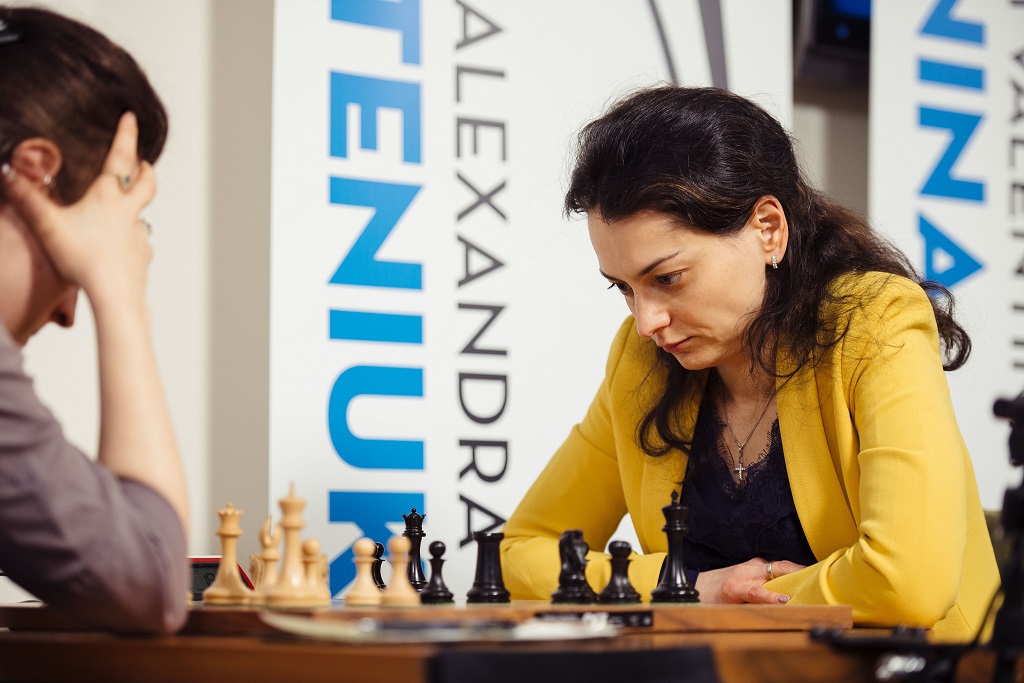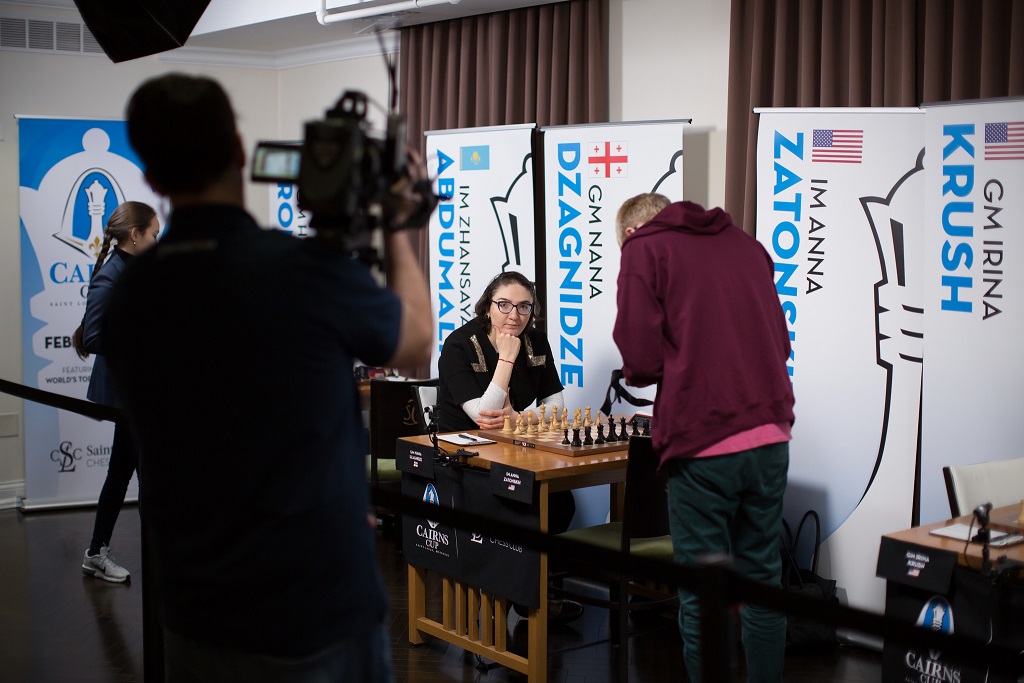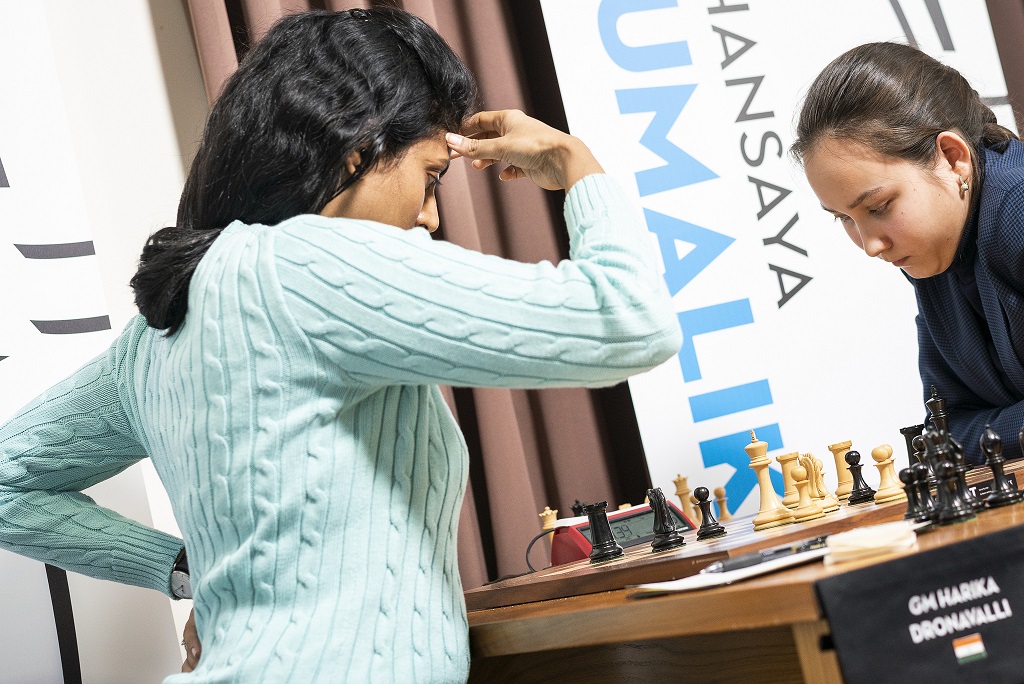


ChessBase 17 - Mega package - Edition 2024
It is the program of choice for anyone who loves the game and wants to know more about it. Start your personal success story with ChessBase and enjoy the game even more.
The big showdown of round six saw Irina Krush arrive well prepared with the white pieces against Alexandra Kosteniuk's Nimzo-Indian Defence. Out of the opening, a tense struggle ensued, in which it was hard to tell who had the upper hand — it was clear that any misstep could tip the balance in either direction, though.
Irina had the initiative, but Alexandra managed to ruin White's pawn structure on the kingside. When, on move 29, Krush gained a pawn with her rook on the seventh rank, Kosteniuk wisely decided to force a perpetual and keep her post at the top of the standings.

Still in the lead after a tough draw | Photo: Austin Fuller / Saint Louis Chess Club
Round six saw Kosteniuk lose the sole lead she had gotten after the third day of competition, however. Valentina Gunina caught up with her after taking down Elisabeth Paehtz with the white pieces. The Russian had kept a slight initiative through the middlegame, but when the queens were traded a rather drawish rook endgame appeared on the board. Nonetheless, each side had seven pawns and there was plenty of room for mistakes.
Eventually, Paehtz decided to allow her opponent to activate her king in exchange of a dangerous passed pawn on the c-file. No less than 63 moves had been played when the German slipped up:
Power Play 16 - Test Your Rook Endgames
The aim of this DVD is to provide you with the practical skills and knowledge that you will need to play a rook and pawn endgame. Based on his own playing experience, Grandmaster Daniel King reveals what is essential knowledge, saving you time in your studies. The Power Play series is suitable for anyone looking to improve their chess, but also provides ready-made lessons and exercises for a trainer.
Running time: 5 hours
The correct way to go was 63...♚d7, preventing the white rook from overseeing the passed pawn from c6 — a sample continuation is 64.♖a6 ♜d5+ 65.♔f4 c3 66.♖a2 ♜c5. Instead, Elisabeth's 63...♜d5+ was followed by 64.♔f4 ♜c5 65.♖f5 ♜c8 66.♖xh5 c3 67.♖e5+ ♚f6 and White is in time to defend from the first rank with 68.♖e1. Notice that after 63...♚d7 Black manages to keep her h-pawn. (Feel free to try these and other variations on the diagram above!)
White's connected passed pawns are too much for Black to handle. Gunina showed good technique and a lot of persistence to finally get the full point after 88 moves.

...sitting on top of the world | Photo: Lennart Ootes / Saint Louis Chess Club
The title of this article has a lot to do with what happened on Dzagnidze-Zatonskih and Harika-Abdumalik.
Both Nana Dzagnidze and Anna Zatonskih were in deep time trouble when they missed great chances to get a decisive advantage. The biggest miss was Zatonskih's, on move 37:
Dynamic play is what makes your chess effective and most importantly fun! Timur Gareyev shows severeal examples which aspects are important to remember when seizing for the initiative!
With the natural 37...♛a3?, Anna was protecting her passed pawn's promotion square. However, it was a little too slow — the direct 37...c2! was stronger due to the threat of mate-in-one on e1 once the white queen moves — i.e. it can only go to f1. The move chosen by Zatonskih gave her opponent a much needed tempo to play 38.g3, getting out of trouble and keeping all her threats alive.
Three moves later — the last one before the time control — it was Nana's turn to falter:
It is clear that White need to attack the weak f7-square. But how to do it? The right way was from f3, as 40.♕h5? allowed 40...♛c1+ 41.♔g2 g6 42.♕f3 f5 — instead, after a direct 40.♕f3 Black's 40...f5 would be useless due to 41.♕h5 as 41...g6 does not work. Move order matters!
A balanced endgame ensued, until Zatonskih made the last mistake on move 48:
After 48...♛g5? White can trap the knight with the queen from d1 — in the game, Nana first gave a check and then gained the piece: 49.♕d6+ ♚e8 50 ♕d1. Zatonskih needed to play a move like 48...♛c7 or 48...♛a3 on the diagrammed position in order to keep an eye on the defenceless knight. The game continued until move 74, when the American resigned.

Nana got her second win of the event | Photo: Spectrum Studios / Saint Louis Chess Club
Harika Dronavalli's first victory in Saint Louis also felt slightly like a roller-coaster ride. She had the white pieces against Zhansaya Abdumalik and reached an infrequent middlegame position with four rooks, four knights and eight pawns per side. In the manoeuvring stage, the players had a chance to repeat the position, but Harika felt she had a slight pull and decided to keep going. This resulted in White getting a clearly inferior position...until Zhansaya erred at a critical point:
Chess Endgames 13 - Double rook endings
Double rook endings occur frequently and are different from single rook endings in several respects.
Abdumalik's passed d-pawn is quite strong, and she needed to push it at once with 63...d3 to keep the initiative. By playing the more conservative 63...♜b7 she allowed White to get the c-pawn after 64.♖c2 d3 65.♖xc4. The computer already gives a 0.00 evaluation at this point, but then Zhamsaya miscalculated again and found herself in a completely lost position:
Once again the youngster needed to play a forcing move but chose a slower, more conservative alternative — 66...♜c2 or 66...d2 were needed, while 66...♞e4? allowed White to double rooks on the seventh rank after 67.♖c7+ ♚e8 68.♖aa7. Harika needed eleven more moves to get Zhansaya to resign. Certainly a very disappointing result for the Kazakh.

Harika prevailed after a tough fight | Photo: Lennart Ootes / Saint Louis Chess Club
After getting her first win, Harika will face Kosteniuk with Black in round seven, surely a welcomed challenge for the ambitious Indian. The other co-leader, Valentina Gunina, will have the black pieces against a wounded Anna Zatonskih.
On this DVD, Grandmaster and worldrenowned commentator Maurice Ashley reviews some of the most interesting patterns with examples meant to educate and entertain.
Commentary by GM Yasser Seirawan, GM Maurice Ashley and WGM Jennifer Shahade